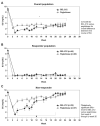The COMPARE head-to-head, randomized controlled trial of SEL-212 (pegadricase plus rapamycin-containing nanoparticle, ImmTOR™) versus pegloticase for refractory gout
- PMID: 37449908
- PMCID: PMC10986798
- DOI: 10.1093/rheumatology/kead333
The COMPARE head-to-head, randomized controlled trial of SEL-212 (pegadricase plus rapamycin-containing nanoparticle, ImmTOR™) versus pegloticase for refractory gout
Abstract
Objectives: Serum urate (SU) lowering with PEGylated uricases in gout can reduce flares and tophi. However, treatment-emergent anti-drug antibodies adversely affect safety and efficacy and the currently approved PEGylated uricase pegloticase requires twice-monthly infusions. Investigational SEL-212 therapy aims to promote uricase-specific tolerance via monthly sequential infusions of a proprietary rapamycin-containing nanoparticle (ImmTOR) and pegadricase.
Methods: COMPARE was a randomized, phase 2, open-label trial of SEL-212 vs pegloticase in adults with refractory gout. SEL-212 [ImmTOR (0.15 mg/kg) and pegadricase (0.2 mg/kg)] was infused monthly or pegloticase (8 mg) twice monthly for 6 months. The primary endpoint was the proportion of participants with SU <6 mg/dl for ≥80% of the time during 3 and 6 months. Secondary outcomes were mean SU, gout flares, number of tender and/or swollen joints and safety.
Results: During months 3 and 6 combined, numerically more participants achieved and maintained a SU <6 mg/dl for ≥80% of the time with SEL-212 vs pegloticase (53.0% vs 46.0%, P = 0.181). The percentage reductions in SU levels were statistically greater during months 3 and 6 with SEL-212 vs pegloticase (-73.79% and -47.96%, P = 0.0161). Reductions in gout flare incidence and number of tender and/or swollen joints were comparable between treatments. There were numerical differences between the most common treatment-related adverse events of interest with SEL-212 and pegloticase: gout flares (60.2% vs 50.6%), infections (25.3% vs 18.4%) and infusion-related reactions (15.7% vs 11.5%), respectively. Stomatitis (and related terms) was experienced by eight participants (9.6%) with SEL-212 and none with pegloticase. Stomatitis, a known event for rapamycin, was associated with ImmTOR only.
Conclusions: SEL-212 efficacy and tolerability were comparable to pegloticase in refractory gout. This was associated with a substantial reduction in treatment burden with SEL-212 due to decreased infusion frequency vs pegloticase.
Clinical trial registration: NCT03905512.
Keywords: SEL-212; gout; nanotechnology; pegadricase; pegloticase; rapamycin; serum urate; uricase.
© The Author(s) 2023. Published by Oxford University Press on behalf of the British Society for Rheumatology.
Figures
Similar articles
-
Improved joint and patient-reported health assessments with pegloticase plus methotrexate co-therapy in patients with uncontrolled gout: 12-month exploratory outcomes of the MIRROR open-label trial.Arthritis Res Ther. 2022 Dec 27;24(1):281. doi: 10.1186/s13075-022-02979-4. Arthritis Res Ther. 2022. PMID: 36575505 Free PMC article.
-
A multicentre, efficacy and safety study of methotrexate to increase response rates in patients with uncontrolled gout receiving pegloticase (MIRROR): 12-month efficacy, safety, immunogenicity, and pharmacokinetic findings during long-term extension of an open-label study.Arthritis Res Ther. 2022 Aug 25;24(1):208. doi: 10.1186/s13075-022-02865-z. Arthritis Res Ther. 2022. PMID: 36008814 Free PMC article.
-
Infusion-related reactions with pegloticase, a recombinant uricase for the treatment of chronic gout refractory to conventional therapy.J Clin Rheumatol. 2014 Dec;20(8):427-32. doi: 10.1097/RHU.0000000000000200. J Clin Rheumatol. 2014. PMID: 25417679 Free PMC article. Review.
-
Pegloticase treatment of chronic refractory gout: Update on efficacy and safety.Semin Arthritis Rheum. 2020 Jun;50(3S):S31-S38. doi: 10.1016/j.semarthrit.2020.04.011. Semin Arthritis Rheum. 2020. PMID: 32620200 Review.
-
Long-term safety of pegloticase in chronic gout refractory to conventional treatment.Ann Rheum Dis. 2013 Sep 1;72(9):1469-74. doi: 10.1136/annrheumdis-2012-201795. Epub 2012 Nov 10. Ann Rheum Dis. 2013. PMID: 23144450 Free PMC article. Clinical Trial.
Cited by
-
Engineered immunological niche directs therapeutic development in models of progressive multiple sclerosis.Proc Natl Acad Sci U S A. 2025 Feb 18;122(7):e2409852122. doi: 10.1073/pnas.2409852122. Epub 2025 Feb 12. Proc Natl Acad Sci U S A. 2025. PMID: 39937858 Free PMC article.
-
A comprehensive overview of tolerogenic vaccine adjuvants and their modes of action.Front Immunol. 2024 Dec 20;15:1494499. doi: 10.3389/fimmu.2024.1494499. eCollection 2024. Front Immunol. 2024. PMID: 39759532 Free PMC article. Review.
-
Emerging therapeutic options for refractory gout.Nat Rev Rheumatol. 2024 Feb;20(2):73-74. doi: 10.1038/s41584-023-01066-5. Nat Rev Rheumatol. 2024. PMID: 38102493 No abstract available.
-
Mechanisms and rationale for uricase use in patients with gout.Nat Rev Rheumatol. 2023 Oct;19(10):640-649. doi: 10.1038/s41584-023-01006-3. Epub 2023 Sep 8. Nat Rev Rheumatol. 2023. PMID: 37684360 Review.
-
Advances in Immune Tolerance Induction in Enzyme Replacement Therapy.Paediatr Drugs. 2024 May;26(3):287-308. doi: 10.1007/s40272-024-00627-9. Epub 2024 Apr 25. Paediatr Drugs. 2024. PMID: 38664313 Free PMC article. Review.
References
-
- Ruoff G, Edwards NL.. Overview of serum uric acid treatment targets in gout: why less than 6 mg/dL? Postgrad Med 2016;128:706–15. - PubMed
-
- Schlesinger N, Lipsky PE.. Pegloticase treatment of chronic refractory gout: update on efficacy and safety. Semin Arthritis Rheum 2020;50(3 Suppl):S31–8. - PubMed
-
- Fels E, Sundy JS.. Refractory gout: what is it and what to do about it? Curr Opin Rheumatol 2008;20:198–202. - PubMed




